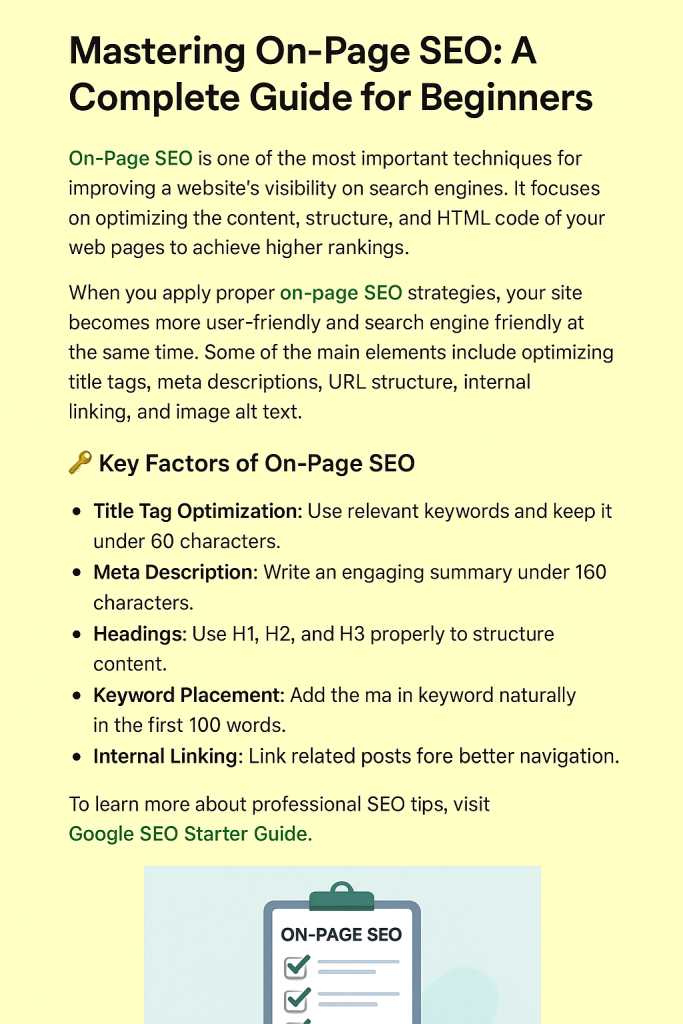Learn how to increase your website traffic using on-page SEO techniques. Discover keyword optimization, internal linking, and multimedia strategies.

Introduction
Are you struggling to get more visitors to your website? 🚀
With the right On-Page SEO techniques, you can turn your site into a powerful traffic magnet. In this post, we’ll explore the most proven strategy that helps search engines understand your content better and attracts the right audience. From optimizing keywords to enhancing user experience, this guide will show you how to make your website rank higher, load faster, and perform better — all through smart On-Page SEO practices.
1. Optimize Your Keywords
Using the right keywords is the foundation of <span style="background-color:green;">On-Page SEO</span>. Include your main keyword naturally in
1. Titles and Headings
Your title and headings should include your main keyword naturally. A well-optimized title helps search engines understand your page topic, while clear headings (H1, H2, H3) improve readability and user experience.
2. URL Structure
Keep your URLs short, clean, and keyword-rich. A descriptive URL not only helps users understand what the page is about but also improves your site’s visibility in search results.
Example: https://www.example.com/on-page-seo-tips
3. Meta Descriptions
Write compelling meta descriptions (around 150–160 characters) with your main keyword. This short snippet appears under your page title in search results and can increase click-through rates when written persuasively.
4. First 100 Words of Content
Include your main keyword in the first 100 words of your content. Search engines give more weight to early content, and readers immediately understand what your page is about—boosting both relevance and engagement.
Example of anchor text with yellow background:
Check SEO tools and tips: <a href="https://www.example.com" style="background-color:yellow;">learn more here</a>.
2. Internal and External Linking
1a. Importance of On-Page SEO
On-Page SEO is crucial because it helps search engines understand your content better, leading to higher rankings. For instance, optimizing your headings and ensuring your keyword density is appropriate can significantly impact your visibility.
Moreover, On-Page SEO directly influences user experience. When users find the information they’re looking for quickly due to clear navigation and optimized content, they are more likely to stay longer on your site, which reduces bounce rates.
Linking helps search engines understand your site structure and builds authority.
- Internal links: Connect related pages within your website.
- External links: Reference authoritative sources to increase credibility.
Use your <span style="background-color:green;">On-Page SEO</span> keyword naturally in anchor text when possible.
3. Multimedia for Engagement
Additionally, keyword research tools like Google Keyword Planner and SEMrush can help identify valuable keywords that match user intent. By focusing on long-tail keywords, you can target specific queries that potential visitors might have.
Implementing LSI (Latent Semantic Indexing) keywords—terms related to your main keyword—can also enhance your content’s relevance. For example, if your primary keyword is “On-Page SEO,” you might include LSI keywords like “SEO best practices,” “website optimization,” and “search engine ranking.” This strategy helps search engines understand the context of your content better.
Adding images and videos keeps visitors engaged and reduces bounce rate.
Example Image:
<img src="https://www.example.com/seo-image.jpg" alt="On-Page SEO Tips" width="600">
Example Video:
<iframe width="560" height="315" src="https://www.youtube.com/embed/VIDEO_ID" title="On-Page SEO Tutorial" frameborder="0" allowfullscreen></iframe>
4. Meta Tags and URL Optimization
- Include your main
<span style="background-color:green;">On-Page SEO</span>keyword in the URL, e.g.,https://www.example.com/on-page-seo-tips - Use keyword-rich meta titles and descriptions.
Incorporating links to high-authority sites enhances credibility, and using nofollow links for less reputable sources can help maintain your site’s integrity. Tools like Ahrefs can assist in assessing the authority of external sites you link to.
5. Image & Video SEO
- Add alt text with keywords for images.
- Add descriptions or transcripts for videos.
This helps search engines understand your multimedia content and improves ranking.
Conclusion
Implementing proper <span style="background-color:green;">On-Pages SEO</span> techniques like keyword optimization, internal linking, and multimedia can significantly improve your website traffic. By continually updating your content and using the strategies mentioned above, you can ensure long-term success. Start today and see the results!
Anchor link example (yellow background):
Explore more SEO guides: <a href="https://www.example.com" style="background-color:yellow;">click here</a>
Consider the use of infographics, as they can simplify complex information and create shareable content that attracts backlinks. Tools like Canva can help you design informative infographics that represent your data visually.
Checklist for On-Page SEO in this post:
- H1/H2/H3 Headings Include Main Keyword
Proper use of headings with keywords improves content structure and helps search engines understand topic hierarchy. - Main Keyword Highlighted with Green Background
Visually emphasizing keywords enhances readability and ensures keyword focus within your content. - Anchor Text Highlighted with Yellow Background
Highlighting anchor texts draws attention to important links and improves internal navigation and user engagement. - Image and Video Included with Proper Alt Text and Description
Optimized multimedia improves accessibility, keeps visitors engaged, and helps search engines understand visual content. - Meta Title, Meta Description, and URL Optimized
Well-optimized metadata and URLs increase click-through rates and make your content more search-friendly.
Furthermore, meta tags play a significant role in click-through rates. Research shows that compelling meta descriptions can improve the likelihood of users choosing your link over others. Incorporating a clear call to action in your meta descriptions can entice users to click.
Image optimization extends beyond alt text. Consider compressing images to reduce loading times, as speed is a ranking factor. Tools like TinyPNG can help compress images without significant loss of quality.
Video content is also increasingly popular for SEO. Consider creating short, informative videos that summarize your blog posts, which can be embedded into the content to enhance engagement.